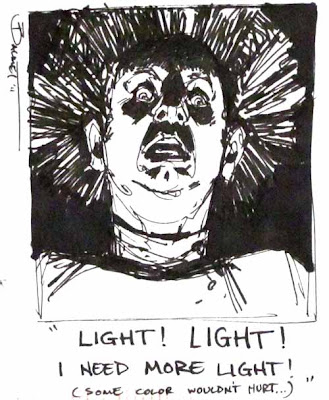One of my distant relatives was an Englishman named Sir Goldsworthy Gurney (1793-1875), who built steam-powered carriages more than 50 years before gasoline automobiles were invented. Unfortunately, he had rather bad luck along the way.

Gurney Steamers ran excursions to Edgeware, Barnet, and Stanmore, reaching top speeds of 20 miles per hour.

In May, 1828, a Gurney carriage climbed Highgate Old Hill, which doubters claimed couldn’t be done. On the way back down, the workmen, in their enthusiasm, forgot to lock the driveshaft to the rear wheels. Gurney, who was at the controls, couldn’t stop the vehicle from careening down the hill. It lost a wheel, though no one was hurt.

In 1829, the Gurney Steam Carriage Company served the route from London to Bath, averaging 14 miles per hour, including stops for water and fuel, nearly double the speed of a horse coach.
On a trip to Longford in heavy fog, Gurney almost crashed head-on with a Bristol mail coach. He swerved onto a pile of bricks to avoid an accident, but broke a drive mechanism in the process. Nevertheless, with power to only one wheel, he managed to pass fifty horse-drawn carriages during the rest of the trip.

Gurney tried various innovations to increase the power of his carriages, including a blast jet, which had the unfortunate effect of blowing cinders out of every orifice of the engine. With the huge pressures involved in the steam engine, passengers became uncomfortable sitting directly atop the boiler (#10 in the illustration above).

Although Gurney was careful to maintain safety standards, one of his coaches, operated without his supervision, blew a boiler, killing two people, and provoking the satirist Thomas Hood to write:
Instead of journeys people now go upon a Gurney
With steam to do the work by power of attorney
But with a load it may explode
And you may be undone
And find you’re going up to heaven
Instead of to London.

His solution: The "Gurney Drag," which towed passengers more safely behind the engine.
In 1831, he built a small “one-horse” steam-powered carriage. It weighed about 500 pounds and was just big enough to carry two or three people or a load of parcels. It could run for seven mile stages, consuming seventy gallons of water and twenty-five bushels of coke at each stop.
But Gurney couldn’t spend much time on such curiosities. In addition to the technical challenges, he had to contend with human obstacles.

On the Bath run one of his carriages was attacked by Luddites. According to Gurney’s daughter Anna, unemployed millworkers from Melksham set upon the carriage, “burnt their fingers, threw stones, and wounded poor Martyn the stoker,” forcing the carriage to be escorted the rest of the way under guard.

Gurney deployed his carriages on paid routes between Gloucester and Cheltenham. In one four-month stretch of 1831, his vehicles carried nearly 3,000 passengers, “including many ladies,” over more than 4,000 miles.
Running a horseless-carriage business didn’t endear Gurney to the horse grooms, horse-carriage builders, turnpike trustees, and railroad men. The magistrates of the Cheltenham district, wishing to block Gurney’s progress, covered a stretch of road with an eighteen-inch-deep layer of rough gravel, which his vehicles couldn’t get across.
Gurney’s biggest rival was the railroad men. They lobbied authorities to hamper Gurney with prohibitive tolls levied on steam conveyances, while railroad developers were receiving government loans. During the time of his experimentation, railroads grew from a single line of track to a 1,500 mile network.

Eventually, stymied by the high tolls, Gurney’s steam carriage business fell apart and he turned his attention to lighthouses and mine ventilation.
If only Sir Goldsworthy had outmaneuvered the Luddites and the railroad men, automobiles would have gotten their start in the 1830s, the Civil War would have been fought with tanks, and we would have been riding "Goldsworthys" instead of Greyhounds, and "Gurneys" instead of Fords. There’s a steampunk novel for you.
---------
Note on the hospital use of the word “gurney.” Another Gurney, Theodore Gurney of Boston, patented a form of horse-drawn vehicle that became known as a “gurney.” According to historian Jean Rigler, unlike the hansom cab, “the gurney was a small scale hack” that could carry two people behind a single horse: “A two-horse hack cost 50 cents, but the gurney was only 25 cents.” In San Francisco, horse-drawn gurney wagons were used by the police for ambulance service, and the term was transferred to the wheeled vehicle used within the hospital.
----------
References:
“Why the Gurney Lost Out,” by Jerry MacMullen, San Diego Union, 1969.
“Gurney: A San Francisco Word Goes National,” by Peter Tamony, The Pacific Winter issue, 1966, p. 15-20
“The Gurney Family from Aaron to Zuinglius: A Genealogical Dictionary,” by Jean Gurney Rigler, Honolulu, HI, 1964.
--------------------
Wikipedia on Sir Goldsworthy Gurney
The Life and Times of Sir Goldsworthy Gurney, Gentleman Scientist and Inventor, by Dale H. Porter (Amazon)
Porter's book on Google Books
Previously on GJ: "
Spokewheeling," showing Dinotopia's Goldsworthy Marlinspike, who was named after Sir G.G.





























































